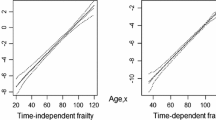Abstract
Reversed hazard rates are found to be very useful in survival analysis and reliability especially in study on parallel systems and in the analysis of left censored lifetime data. In this paper, we derive a class of bivariate distributions having marginal proportional reversed hazard rates. We, then, introduce a class of proportional reversed hazard rates frailty models and propose a multivariate correlated gamma frailty model. Bivariate reversed hazard rates and association measure are discussed in terms of frailty parameters.
Similar content being viewed by others
References
Andersen PK, Borgan O, Gill RD and Keiding N (1993). Statistical methods based on counting processes. Springer, New York
Bismi G (2005) Bivariate burr distributions. Ph.D. thesis, Cochin University of Science and Technology, India (unpublished)
Block HW, Savits TH and Singh H (1998). The reversed hazard rate function. Probab Eng Inform Sci 12: 69–90
Chen YQ, Wang MC and Huang Y (2004). Semiparametric regression analysis on longitudinal pattern of recurrent gap times. Biostatistics 5(2): 277–290
Clayton DG (1978). A model for association in bivariate life tables and its application in epidemiological studies of familial tendency in chronic disease incidence. Biometrika 65: 141–151
Clayton DG and Cuzick J (1985). Multivariate generalizations of the proportional hazards model. J R Stat Soc Ser A 148(2): 82–117
Di Crescenzo A (2000). Some results on the proportional reversed hazards model. Stat Probab Lett 50: 313–321
Finkelstein MS (2003). On one class of bivariate distributions. Stat Probab Lett 65: 1–6
Gupta RD and Nanda AK (2001). Some results on reversed hazard rate ordering. Commun Stat Theory Methods 30: 2447–2457
Gupta RC and Wu H (2001). Analyzing survival data by proportional reversed hazard model. Int J Reliab Appl 2(1): 1–26
Gupta RC, Gupta PL and Gupta RD (1998). Modelling failure time data by Lehman alternative. Commun Stat Theory Methods 27: 887–904
Hougaard P (2000). Analysis of multivariate survival data. Springer, New York
Jones G and Rocke DM (2002). Multivariate survival analysis with doubly censored data: application to the assessment of accutane treatment for fibrodysplasia ossificans progressiva. Stat Med 21: 2547–2562
Kalbfleisch JD and Lawless JF (1989). Interface based on retrospective ascertainment: an analysis of the data based on transfusion-related AIDS. J Am Stat Assoc 84: 360–372
Kaplan EL and Meier P (1958). Nonparametric estimation from incomplete observations. J Am Stat Assoc 53: 457–481
Keilson J and Sumitha U (1982). Uniform stochastic ordering and related inequalities. Can J Stat 10: 181–198
Lawless JF (2003). Statistical models and methods for lifetime data. Wiley, New York
Nair NU, Sankaran PG and Asha G (2005). Characterizations of distributions using reliability concepts. J Appl Stat Sci 14: 237–242
Roy D (2002). A characterization of model approach for generating bivariate life distributions using reversed hazard rates. J Jpn Stat Soc 32(2): 239–245
Sankaran PG and Gleeja VL (2006). On bivariate reversed hazard rates. J Jpn Stat Soc 36(2): 213–224
Sengupta D, Singh H, Nanda AK (2006) The proportional reversed hazard model. (Personal communication)
Vaupel JW, Manton KG and Stallard E (1979). The impact of heterogeneity in individual frailty on the dynamics of mortality. Demography 16: 439–454
Yashin AI and Iashine IA (1997). How frailty models can be used for evaluating longevity limits: taking advantage of an interdisciplinary approach. Demography 34(1): 31–48
Yashin AI and Iashine IA (1999). Dependent hazards in multivariate survival problems. J Multivariate Anal 71: 241–261
Author information
Authors and Affiliations
Corresponding author
Rights and permissions
About this article
Cite this article
Sankaran, P.G., Gleeja, V.L. Proportional reversed hazard and frailty models. Metrika 68, 333–342 (2008). https://doi.org/10.1007/s00184-007-0165-0
Received:
Published:
Issue Date:
DOI: https://doi.org/10.1007/s00184-007-0165-0




